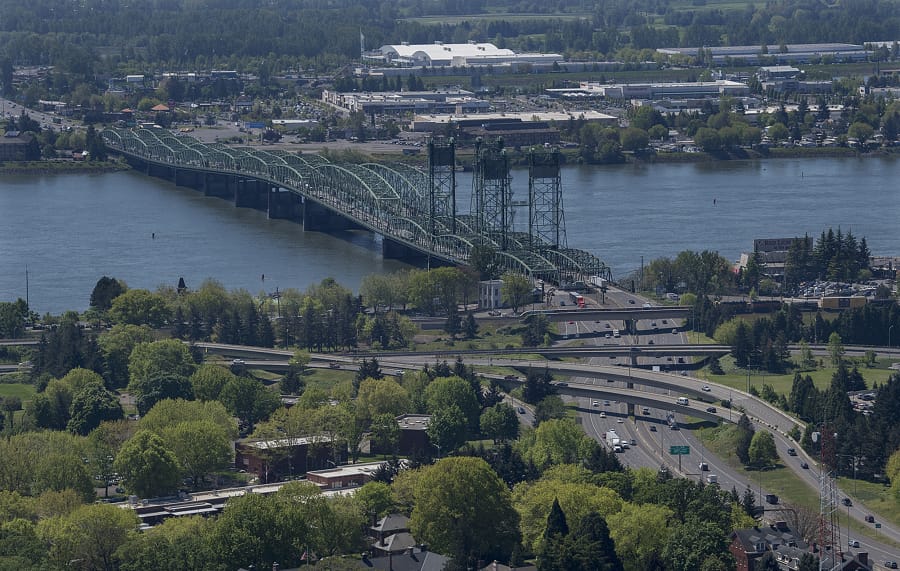There are two topics that tend to be the most contentious in any discussion about replacing the Interstate 5 Bridge: high-capacity transit and alternative crossing options.
The mass transit issue in particular is often cited as one of the factors behind a legislative deadlock that derailed the Columbia River Crossing replacement project in 2013.
Washington and Oregon embarked on a new replacement effort last year, and the bistate legislative committee tasked with overseeing the new Interstate Bridge Replacement Program tackled both issues head-on at a virtual meeting Thursday afternoon.
The meeting was devoted solely to the mass transit and alternative crossing topics, with the goal of providing the 16 lawmakers who make up the committee with a recap of how the Columbia River Crossing team examined those issues and arrived at its Locally Preferred Alternative.
Officials at the new project’s bistate office also sought to outline their plan for how the new project would approach those issues when drafting a Supplemental Environmental Impact Statement, and to gather feedback from the committee members.
In both cases, much of the discussion between committee members and project officials focused on the question of how much of the work put into the CRC planning process could be reused. Multiple legislators expressed a reluctance to start entirely from scratch.
“We spent a whole lot of money last time, and I don’t want to have to unnecessarily duplicate that,” said Oregon state Sen. Lee Beyer, D-Springfield, Ore.
But there was also a resistance to the idea of simply picking up where the CRC left off, and calls to take a renewed look at some of the alternative options.
“I know a lot of these things may have been asked and answered, but I think we need to have a current response and current answers,” said Washington state Rep. Sharon Wylie, D-Vancouver.
Interstate Bridge Replacement Program administrator Greg Johnson replied that the new project would need to account for changes to the surrounding area that have occurred in the near-decade since the CRC got its initial greenlight, such as new buildings on Hayden Island and along the waterfront in Vancouver – but he added that his office didn’t intend to ignore work from the prior project.
The CRC was in development for about 14 years, Johnson noted, but the Interstate Bridge Replacement Program has to move faster because of a looming deadline.
Washington and Oregon are on the hook to pay back $140 million in federal dollars spent on the CRC unless they show substantial progress toward a replacement bridge. The original deadline has already been extended twice, most recently to September 2024. A third extension is unlikely, Johnson said.
The Washington State Department of Transportation’s southwest regional administrator, Carley Francis, ran through a recap of the mass transit planning process for the CRC, and Interstate Bridge Replacement Project assistant administrator Frank Green gave a similar presentation about the CRC’s analysis of alternate crossing options.
The high-capacity transit process for the CRC began with a list of 15 ideas, Francis said, including concepts like a monorail, maglev train or ferry service, which was narrowed down to two options for the Draft Environmental Impact Statement to examine: light rail and bus rapid transit.
Either scenario would have also maintained C-Tran’s existing express bus service. Light rail was ultimately selected and incorporated into the Locally Preferred Alternative for the CRC project.
The crossing alternatives analysis for the CRC began with 23 options, Green said, including a replacement bridge, a tunnel, a third span to supplement the existing bridge and a new bridge in some other location. The Draft Environmental Impact Statement narrowed it down to a replacement or a supplemental bridge, and the replacement option was selected as the CRC’s locally preferred alternative.
Johnson, Green and Francis outlined their planned development approach for both issues on the new project, both of which involved developing a range of alternatives, narrowing the list down, creating a Draft Environmental Impact Statement and then narrowing the remaining alternatives down to a single choice.
The current timeline calls for the project office to provide the committee with an update on its preliminary list of alternatives for both topics in the winter, then come back in the spring to receive guidance on the range of alternatives to be analyzed in the Supplemental Draft Environmental Impact Statement.
The new project’s bistate office is trying to arrive at an efficient decision-making process with substantial public involvement, Johnson said, to avoid a scenario where the project arrives at a design choice that ends up having to be reexamined.
“We’re not going to skip any steps, but we are — once decisions are made, those decisions will get put in the bank, and we cannot go back and revisit them with the time frame we have,” he said.




